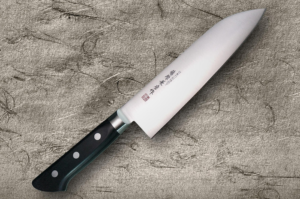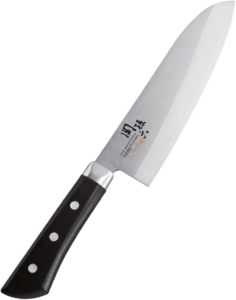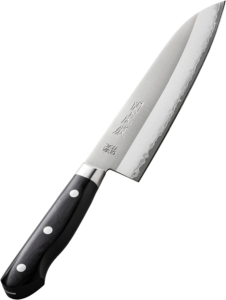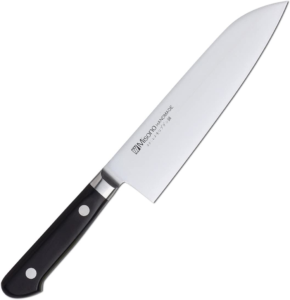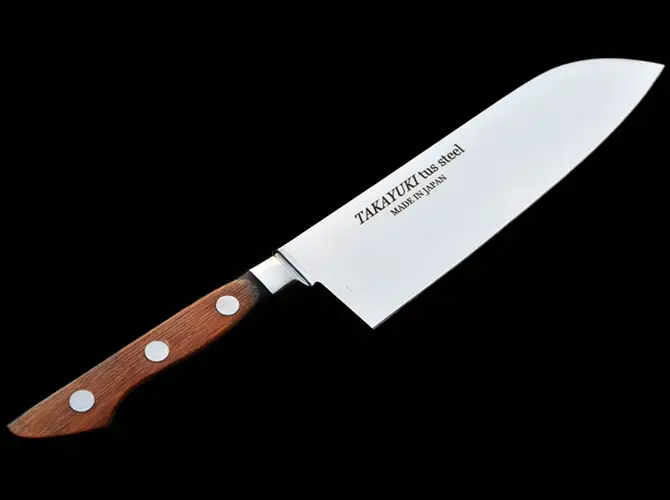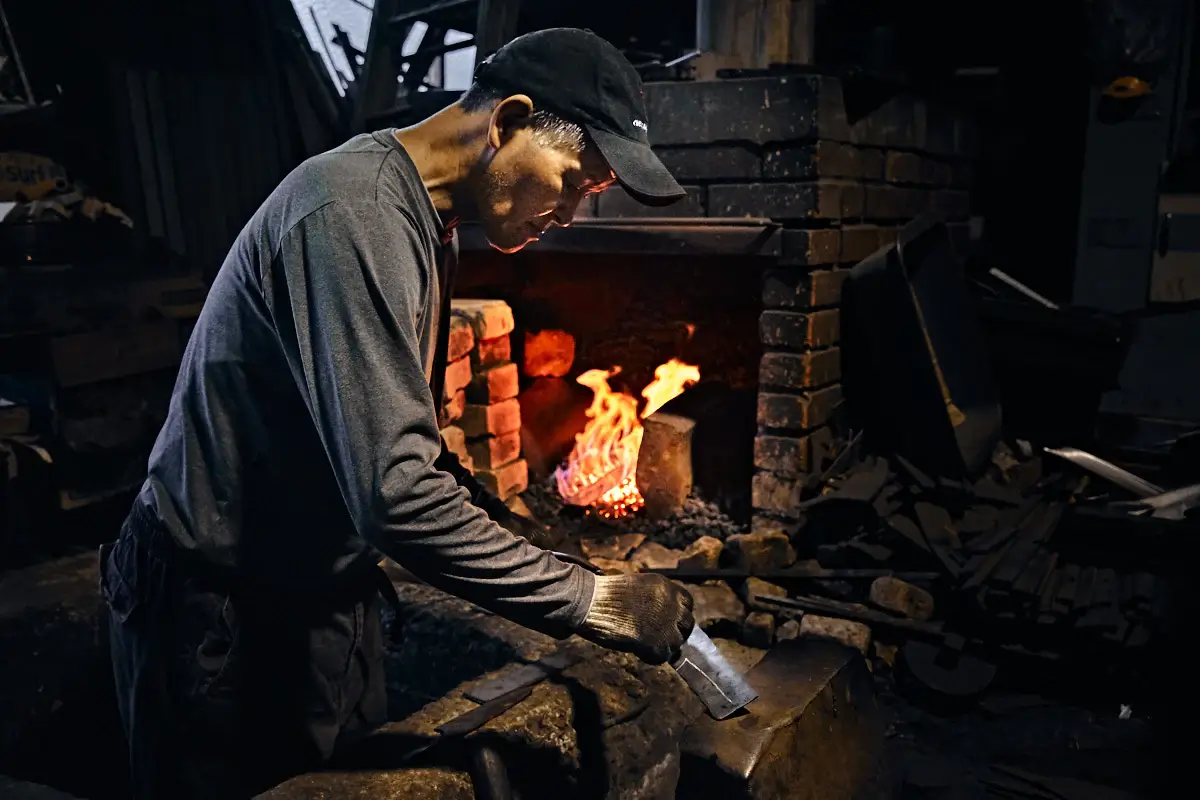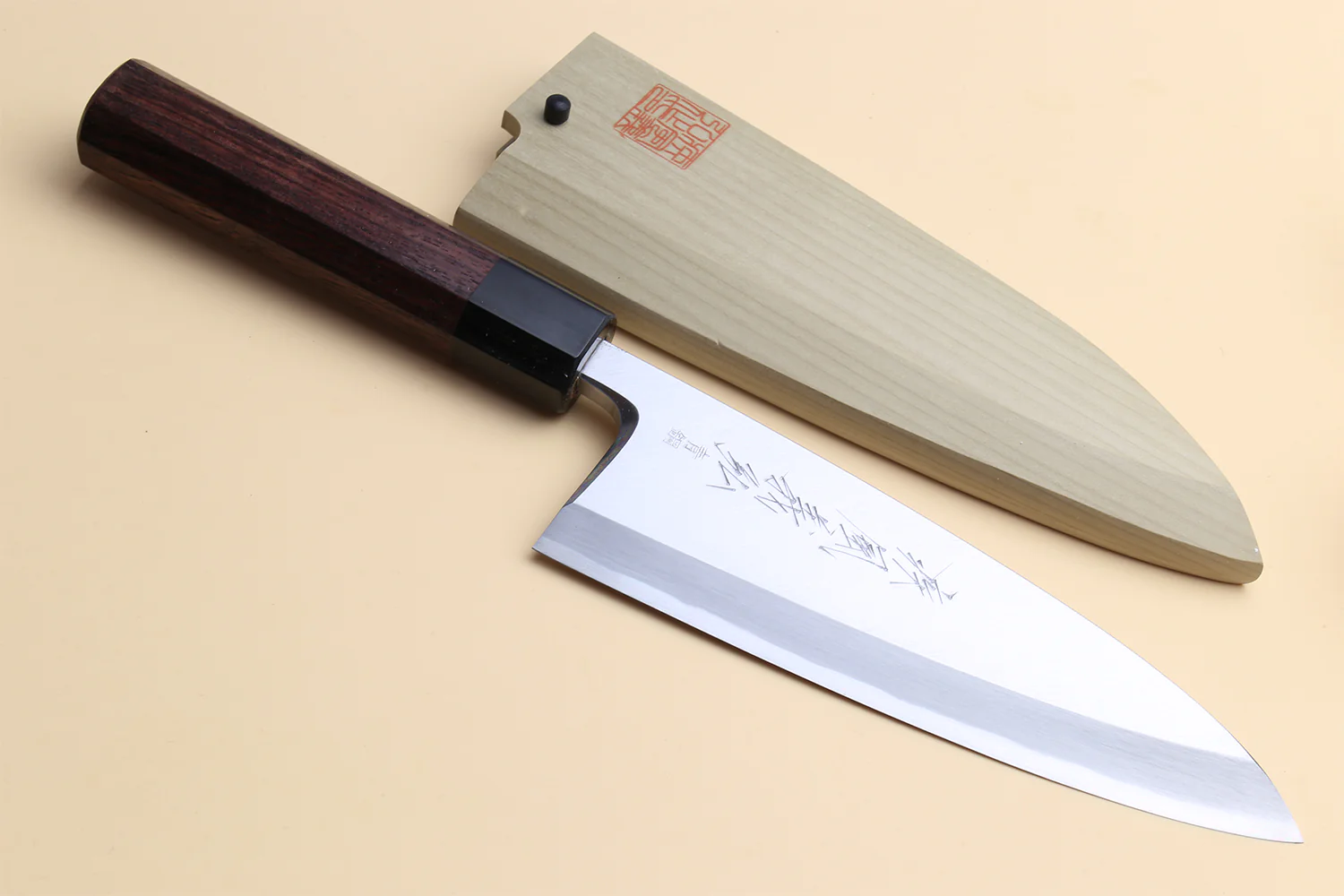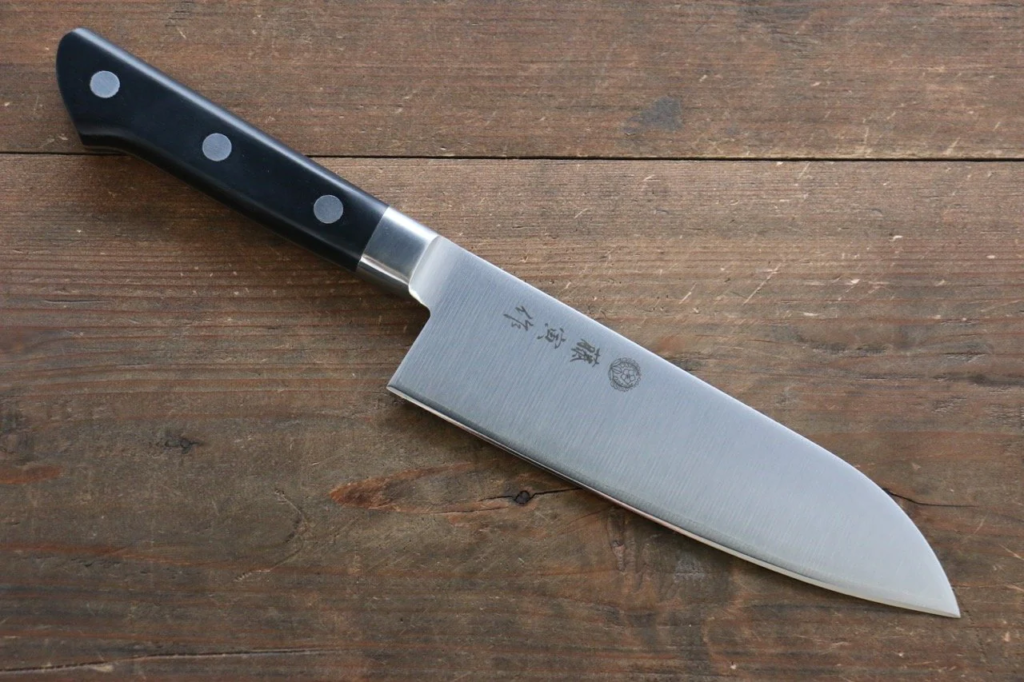
TL;DR
If you’re in a rush, here are my picks of the best santoku knives under $100:
- Best value: Fujiwara FKM or Hoshanho Damascus Santoku
- Best quality: Tojiro DP Santoku
- Best priced (i.e. cheapest): Kai Seki Magoroku Santoku
Today, I take a look at the best santoku knives under $100 (USD).
Authentic Japanese kitchen knives can be very expensive. Most cost well over $100; many easily go over $200.
That’s a lot of money for a knife! This is especially true if you’re just starting out, on a tight budget, or just cheap like me. 🙂
Unfortunately for us cheapos, lower priced knives tend to be weird China knock-offs, or just poor quality overall (i.e. don’t hold an edge, not sharp out of the box, don’t cut well, etc.) When it comes to Japanese knives, the saying, “you get what you pay for” typically holds true.
So, what should you do?
Luckily for you, I have done the research, filtered through the junk, and found some hidden gems.
Keep reading for my top picks:
The Best Santoku Knives for under $100
The knives below are budget friendly, but still maintain the quality you expect from authentic Japanese knives.
I tried to pick knives that are around the same length (if possible) to make it more comparable. They are also all easily purchasable online (i.e. via Amazon or other shop).
First, here is a quick table of my top picks. Scroll down further for more detailed descriptions.
Disclaimer: The Chef Dojo may receive a small commission if you decided to purchase through some of these links. It helps to support the website. Thanks!
Comparison Table
| Comment | Photo | Product Name | Steel | Blade length | Price | Link |
|---|---|---|---|---|---|---|
| Best Value |  | MAC Superior Santoku | MV Stainless | 165mm (6.5”) | $75 | Amazon |
| Best Value #2 | 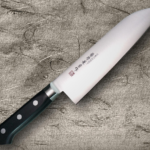 | Fujiwara Kanefusa Molybdenum (FKM) | AUS-8 stainless | 180mm (7”) | $75 | Hocho Knife |
| Best Quality |  | Tojiro DP | VG-10 stainless | 170mm (6.7”) | $92 | Amazon |
| Cheapest | 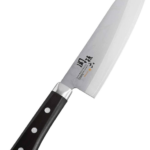 | Kai Seki Magoroku Akane | High carbon stainless | 165mm (6.5”) | $32 | Amazon |
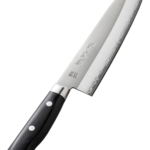 | Yasuda Hamano Seki Kotetsu | VG-10 stainless | 180mm (7”) | $60 | Amazon | |
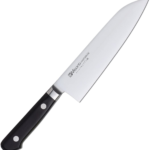 | Misono Molbydenum | AUS-8 stainless | 180mm (7”) | $88 | Amazon | |
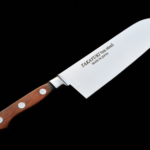 | Sakai Takayuki TUS | TUS stainless | 180mm (7”) | $84 | Hocho Knife |
Best value: MAC Superior Santoku Knife (6.5″ / 165mm)
Best value
MAC Superior Santoku (6.5″)
- Best value
- Recommended in “Cook’s Illustrated”
- Lightweight, thin sharp blade
- Price (at time of publish): $75
Key Specifications:
- Steel: MV stainless steel
- Weight: 5.4oz / 153grams
- Height: 1.83″ / 46.5mm
- Blade Length: 6.5″ / 165mm
- Overall Length: 11.69″ / 297mm
- Blade Thickness: 2mm
- Handle: Western style; pakka wood
MAC Knife is a highly reputable brand that makes great quality, entry level Japanese knives.
The MAC Superior Santoku is one of their more popular knives, as it was featured in the popular “Cook’s Illustrated” magazine awhile back.
The blade is made with a proprietary Molybdenum Vanadium (MV) stainless steel, which takes and retains its edge well. It uses a mono-steel type construction, which means the blade is made entirely from a single piece of steel (not layered or cladded).
The Western style handle is a basic pakka wood. It’s not much to look at, but gets the job done.
Overall, the MAC Superior Santoku is just an excellent, basic, all-around santoku knife. It is very lightweight (maybe feels too light/delicate for some), comes sharp out of the box, and is suitable for day-to-day use.
Best of all, it only costs around $75 (at time of writing). At this price, it is easily one of the best value knives on this list!
Also available at: Mac Knife, Chef Knives to Go
Best value #2: Fujiwara Kanefusa Molybdenum (FKM) Santoku
- Super value
- Great for beginners
- 70/30 edge bevel (right-handed only)
- Price (at time of publish): $75
Key Specifications:
- Steel: AUS-8 stainless steel
- Weight: 5.8oz / 165grams
- Height: 1.85″ / 47mm
- Blade Length: 7″ / 180mm
- Overall Length: 11.8″ / 300mm
- Blade Thickness: 0.087″ / 2.2mm
- Handle: Western style; pakka wood
The Fujiwara Kanefusa Molybdenum (FKM) series of knives are loved by budget-conscious knife enthusiasts everywhere.
They are known for their good cutting performance, easy maintenance, and of course…cheap price.
The blade of FKM knives use AUS-8 stainless steel. It is not the hardest (HRC 57-58), but takes a good edge, and is easy to sharpen/maintain. Beginners are often recommended to start with a AUS-8 or similar steel type.
The handle uses a basic black pakka wood that is common in most budget knives.
It is important to note that the blade bevel of the FKM santoku is not symmetrical. It has a 70/30 grind, which makes it only suitable for right handed users. Some shops will offer custom left-handed versions for a higher price.
Overall, this is easily one of the best santoku knives under $100. It currently retails for around $75. You can often find discounts for even better deals (e.g. Hocho Knife currently has 20% off)
Left handed versions available at: JapaneseChefsKnife.com
Best quality: Tojiro DP Santoku (6.7″ / 170mm)
Best quality
Tojiro DP Santoku (170mm)
- Excellent steel core (VG-10)
- Durable design (Good Design Award 1996)
- Very reputable brand
- Price (at time of publish): $92
Key Specifications:
- Steel: VG-10 (core); 13 Chrome Stainless Steel (cladding)
- Weight: 6.7oz / 190grams
- Height: 1.83″ / 46.5mm
- Blade Length: 6.7″ / 170mm
- Overall Length: 11.6″ / 295mm
- Blade Thickness: 2mm
- Handle: Western style; laminated wood with metal bolster
Tojiro is a well recognized Japanese knife brand known for creating high quality, budget-friendly knives.
The Tojiro DP Santoku is part of their famous DP line of knives that has been selling for many, many years. In fact, it won a Good Design “Long Life Design Award” way back in 1996. Since then, many knife makers have tried to copy the design.
Despite the copycats, it continues to be one of Tojiro’s best selling knives, which is a nod to its quality and durability.
The blade uses a VG-10 core (HRC 60), cladded with softer stainless steel. The core gives the knife excellent cutting performance, while the softer cladding improves it’s durability and makes it easier to sharpen.
The well constructed handle is made with a composite/laminated wood, and designed to be durable enough for use in professional kitchens.
One possible downside of the Tojiro DP is that it is a bit heavy relative to other Japanese knives. It weighs about 190grams. Compare this to the above MAC which ways just 153grams. If you prefer something with more weight though, then it could be a good thing.
The Tojiro DP currently retails for around $92. It used to be much cheaper, but has been going up steadily. I guess the company realized they should be selling for a higher price!
Overall, this is still one of the best (and most durable) santoku knives on the market. Make sure you get yours while it’s still under $100!
Also available at: Hocho Knife, Chef Knives to Go
Best price: Kai Seki Magoroku Akane Santoku (165mm)
Cheapest
Kai Seki Magoroku Akane
- Cheap
- Dishwasher safe
- Very lightweight
- Price (at time of publish): $31.50
Key Specifications:
- Steel: High carbon stainless steel
- Weight: 4.87oz / 138grams
- Height: 1.89″ / 48mm
- Blade Length: 6.5″ / 165mm
- Overall Length: 11.69″ / 293mm
- Handle: Western style; POM resin
Kai is the same company behind the popular knife brand “Shun“. The “Seki Magoroku” brand is one of their other, more affordable line of knives. The name is a bit long; probably why it’s not as popular in Western countries.
The blade of this santoku is made with a basic three layer stainless steel. It is not disclosed what type of steel it is, but we can assume it’s some sort of cheaper, softer MV steel.
The Western style handle is made with a plastic material (POM resin). It is much cheaper feeling than other knives on this list which all have wooden handles. It is also very lightweight, which helps make this knife the lightest on this list (138grams).
The main advantage of using a cheaper steel and plastic handle is that this knife can be washed in the dishwasher! Woohoo! It is the only knife on this list that can be washed in a dishwasher.
Best of all, it only costs around $31 (at time of writing). If you’re just a casual home cook looking for a decent kitchen knife, then this could be the best santoku for you.
Also available at: Amazon Japan, Kai Group
Yasuda Hamano Seki Kotetsu Santoku (7″ / 180mm)
- Great price
- VG10 stainless steel
- Longer blade length
- Price (at time of publish): $60
Key Specifications:
- Steel: VG10 (core); SUS410 (cladding)
- Weight: 5.57oz / 158grams
- Height: 1.8″ / 45.7mm
- Blade Length: 7″ / 180mm
- Overall Length: 12″ / 305mm
- Blade Thickness: 0.07″ / 2mm
- Handle: Western style; laminated wood
Yasuda Hamano is a smaller, lesser known Japanese brand based out of the famous knife making town of Seki.
This knife blade has a very similar construction to Tojiro DP Santoku. It is made with a VG10 core, and softer stainless cladding (SUS410).
It has a longer blade than the Tojiro though, measuring around 180mm (7.08″). A longer blade makes it easier to cut through larger ingredients (e.g. melons, etc.).
The Western style handle is made with a laminated wood, and slightly rounded for more extra comfort.
The Yasuda Hamano Seki Kotetsu is very affordable, selling for just $60. If you don’t mind trying a lesser known brand, then this is a great deal. It is actually one of the top selling knives on Amazon Japan.
Misono Molybdenum Santoku (7″ / 180mm)
- Excellent value
- Very reputable company / brand
- 70/30 bevel (only for right handers)
- Price (at time of publish): $88
Key Specifications:
- Steel: AUS-8 stainless steel
- Weight: 5.3oz / 152grams
- Height: 1.8″ / 47mm
- Blade Length: 7″ / 180mm
- Overall Length: 12″ / 305mm
- Blade Thickness: 0.07″ / 2mm
- Handle: Western style; pakka wood
Misono is one of the most reputable professional knife brands from Japan. They are also based out of the famous knife making town of Seki.
Most of Misono’s knives are well over $100, but they do have one budget-friendly line of knives — the Molybdenum Steel Series (i.e. this knife).
The Molybdenum Santoku blade uses an AUS-8 stainless steel which has a hardness rating of around HRC 57. It is slightly softer steel, but has good cutting performance and is easy to maintain/sharpen. It is good steel for beginners.
The typical looking Western style handle is made of pakka wood and attached with two rivets.
One important thing to note is that the bevel of this knife has 70/30 grind. This means it is steeper on one side of the edge, and is only meant for right handed users.
If you are right handed though, then this Misono santoku is a superb choice. For $88 (only $72 on Amazon at time of writing), it is also fantastic value. It is also available in three sizes (140mm, 160mm, 180mm).
For more sizes, check out at: Hocho Knife, Japanese Chef’s Knife
Sakai Takayuki TUS Steel Santoku (180mm)
- Good value
- Very reputable brand
- Super thin blade
- Price (at time of publish): $84
Key Specifications:
- Steel: TUS stainless steel
- Weight: 6.35oz / 180grams
- Height: 1.83″ / 46.4mm
- Blade Length: 7″ / 180mm
- Overall Length: 11.8″ / 300mm
- Blade Thickness: 0.067″ / 1.7mm
- Handle: Western style; pakka wood
Sakai Takayuki is one of the largest, and most famous Japanese knife makers.
The TUS Santoku is one of their more budget friendly offerings.
The blade is made with a proprietary Molybdenum Vanadium stainless steel called TUS or Takayuki Special steel. There is not much info on this steel, but it is supposedly similar to AUS-8 stainless steel, and hardness of approximately HRC 58.
It uses a mono-steel type construction, which allows it to take a super thin blade. In fact, it is the thinnest blade on this list at just 1.7mm.
The handle is made of pakka-wood, and is also the only brown colored handle on this list! If you’re just sick of those boring black handles, then this could be the santoku for you. 😉
The Sakai Takayuki TUS Santoku retails for around $80, but is currently on sale for just $70 at Hocho Knife (.
Also available at: Seisuke Knife
How Do I Choose a Santoku?
There are a few things to consider when choosing a santoku (or any Japanese knife):
Steel type
You can choose between stainless steel or high carbon steel blades. Most budget friendly knives are stainless steel (i.e. every knife on this list). High carbon steel blades (i.e. White Steel / Blue Steel) are known for having slightly better cutting performance, but are also more difficult to sharpen and maintain. They are typically meant for professionals.
For more about steel types, click here.
Blade length
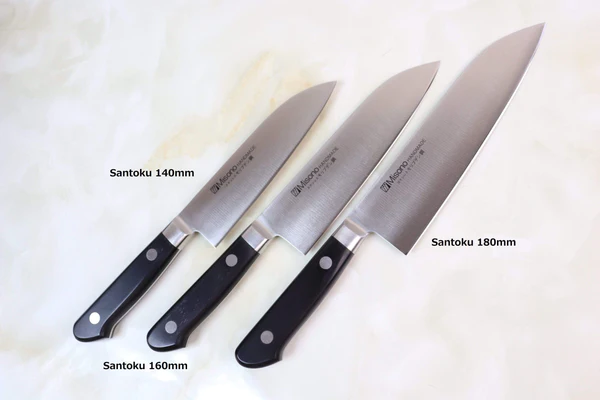
Santoku knives usually range in blade lengths from around 5″ to 7″ (~125mm to 180mm). The choice comes down to personal preference and needs. If you have a smaller kitchen, or just need to cut small ingredients, a shorter knife may be more practical. If you need to cut large ingredients often, then a longer blade is more useful.
Handle type
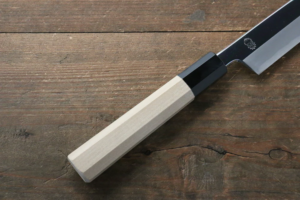
Santoku knives can be found with either Western style handles or traditional Japanese style handles. Western handles are typically grip shaped, with a heavier and sturdier feel. Traditional Japanese style handles are cylindrical shaped, and lighter. This allows for better control for intricate/detailed cutting tasks. For basic cutting/chopping, a Western style handle is usually preferred.
Brand / Manufacturer
I always recommend buying Japanese kitchen knives from a reputable Japanese brand or maker. There are a lot of strange knock-offs, especially on shops like Amazon. Stick with authentic brands (i.e. Tojiro, Misono, Sakai Takayuki, etc.) and you know you are getting a quality knife.
Other Santoku FAQ
What are Santoku knives best for? Can you cut meat with a santoku?
Santoku is an all-purpose kitchen knife. The name of the knife (三徳) literally means “three specialities / virtues”, and is referring to the knife’s ability to cut meat, fish, or vegetables.
Should I get a chef’s knife (i.e. Gyuto) or Santoku?
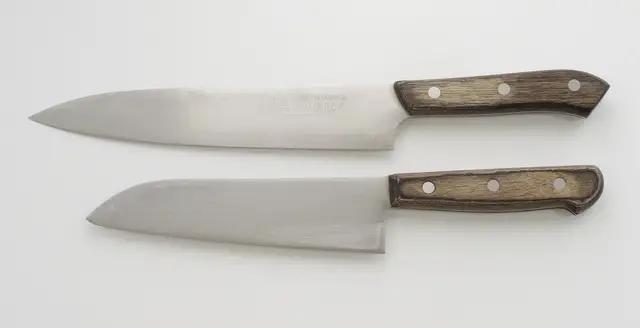
A gyuto (or Japanese chef’s knife) is another all-purpose Japanese kitchen knife. It typically has a longer blade ranging from about 200mm to 250mm+ (7.8 inches to 10+ inches). The blade profile is also usually a bit more curved with a pointier tip. If you want a longer blade, then get a gyuto. For home users, the more compact santoku is sometimes more practical.
For the best gyuto under $100, check out this post.
How to use a santoku knife?
A santoku can be used with all basic cutting techniques. You should use a push-cut motion for most purposes. For a review of basic knife skills, check out Japanese knife skills 101.
How do I sharpen a santoku knife?
A santoku knife should be sharpened with a whetstone. For a step-by-step sharpening guide, check out this article.
For some whetstone recommendations, click here.
Summary
There you have it. The 7 best santoku knives you can buy for under $100.
Overall, the Fujiwara FKM Santoku or MAC Superior gives the best bang for your buck. They offer the best balance between quality and price.
If you want highest quality from reputable brands, then I would go for the Tojiro DP or Misono Molybdenum.
If you just want the cheapest (but still decent quality), then the Kai Seki Magoroku is for you.
Now, I’d like to hear from you:
Which santoku did you buy?
Or, did I miss one on my list?
Either way, let me know by leaving a comment below.

